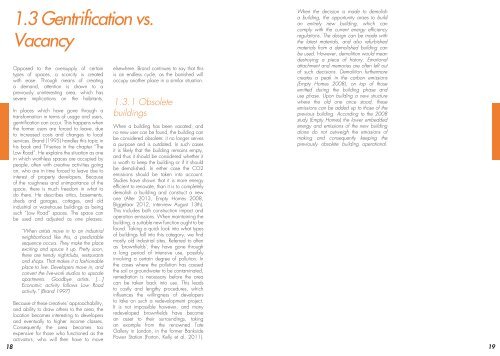View/Open - Aaltodoc
View/Open - Aaltodoc
View/Open - Aaltodoc
You also want an ePaper? Increase the reach of your titles
YUMPU automatically turns print PDFs into web optimized ePapers that Google loves.
1.3 Gentrification vs.<br />
Vacancy<br />
Opposed to the oversupply of certain<br />
types of spaces, a scarcity is created<br />
with ease. Through means of creating<br />
a demand, attention is drawn to a<br />
previously uninteresting area, which has<br />
severe implications on the habitants.<br />
In places which have gone through a<br />
transformation in terms of usage and users,<br />
gentrification can occur. This happens when<br />
the former users are forced to leave, due<br />
to increased costs and changes to local<br />
services. Brand (1995) handles this topic in<br />
his book and TV-series in the chapter “The<br />
Low Road”. He explains the situation as one<br />
in which worthless spaces are occupied by<br />
people, often with creative activities going<br />
on, who are in time forced to leave due to<br />
interest of property developers. Because<br />
of the roughness and unimportance of the<br />
space, there is much freedom in what to<br />
do there. He describes attics, basements,<br />
sheds and garages, cottages, and old<br />
industrial or warehouse buildings as being<br />
such “Low Road” spaces. The space can<br />
be used and adjusted as one pleases.<br />
“When artists move in to an industrial<br />
neighborhood like this, a predictable<br />
sequence occurs. They make the place<br />
exciting and spruce it up. Pretty soon,<br />
there are trendy nightclubs, restaurants<br />
and shops. That makes it a fashionable<br />
place to live. Developers move in, and<br />
convert the live-work studios to upscale<br />
apartments. Goodbye artists. [...]<br />
Economic activity follows Low Road<br />
activity.” (Brand 1997)<br />
elsewhere. Brand continues to say that this<br />
is an endless cycle, as the banished will<br />
occupy another place in a similar situation.<br />
1.3.1 Obsolete<br />
buildings<br />
When a building has been vacated, and<br />
no new user can be found, the building can<br />
be considered obsolete: it no longer serves<br />
a purpose and is outdated. In such cases<br />
it is likely that the building remains empty,<br />
and thus it should be considered whether it<br />
is worth to keep the building or if it should<br />
be demolished. In either case the CO2<br />
emissions should be taken into account.<br />
Studies have shown that it is more energy<br />
efficient to renovate, than it is to completely<br />
demolish a building and construct a new<br />
one (Alter 2013, Empty Homes 2008,<br />
Biggelaar 2012, interview August 13th).<br />
This includes both construction impact and<br />
operation emissions. When maintaining the<br />
building, a suitable new function ought to be<br />
found. Taking a quick look into what types<br />
of buildings fall into this category, we find<br />
mostly old industrial sites. Referred to often<br />
as ‘brownfields’, they have gone through<br />
a long period of intensive use, possibly<br />
involving a certain degree of pollution. In<br />
the cases where the pollution has caused<br />
the soil or groundwater to be contaminated,<br />
remediation is necessary before the area<br />
can be taken back into use. This leads<br />
to costly and lengthy procedures, which<br />
influences the willingness of developers<br />
to take on such a redevelopment project.<br />
It is not impossible however, and many<br />
redeveloped brownfields have become<br />
an asset to their surroundings, taking<br />
an example from the renowned Tate<br />
Gallery in London, in the former Bankside<br />
Power Station (Forton, Kelly et al. 2011).<br />
When the decision is made to demolish<br />
a building, the opportunity arises to build<br />
an entirely new building, which can<br />
comply with the current energy efficiency<br />
regulations. The design can be made with<br />
the latest materials, and also refurbished<br />
materials from a demolished building can<br />
be used. However, demolition would mean<br />
destroying a piece of history. Emotional<br />
attachment and memories are often left out<br />
of such decisions. Demolition furthermore<br />
creates a peak in the carbon emissions<br />
(Empty Homes 2008), on top of those<br />
emitted during the building phase and<br />
use phase. Upon building a new structure<br />
where the old one once stood, these<br />
emissions can be added up to those of the<br />
previous building. According to the 2008<br />
study (Empty Homes) the lower embedded<br />
energy and emissions of the new building<br />
alone do not outweigh the emissions of<br />
making and consequently keeping the<br />
previously obsolete building operational.<br />
Because of these creatives’ approachability,<br />
and ability to draw others to the area, the<br />
location becomes interesting to developers<br />
and eventually to higher income classes.<br />
Consequently the area becomes too<br />
expensive for those who functioned as the<br />
activators, who will then have to move<br />
18 19
















